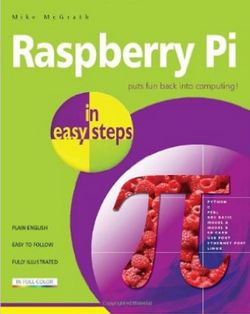| Raspberry Pi in Easy Steps |
|
Author: Mike McGrath Raspberry Pi can mean all things to all people - so what do you want to know and can an In Easy Steps book help you? This is a very simple introduction to Raspberry Pi and if you know anything much about hardware and software then you won't want to read this book. It introduces a lot of software and a little about the hardware towards the end.
The book starts off with an overview of the Pi and how to set it up including consideration of which Linux to use with it - Raspbian is the one picked fro the rest of the book. By the end of the first section you have created a boot SD, started Linux, use the console to configure it and started the desktop. The second part is on using the desktop and it is all fairly obvious stuff but reassuring if you find Linux a bit alien. The topic is continued in part 3 which explains using the console with some basic Linux commands. The brings the part of the book that you might well call Linux 101 to an end. If you aren't a Linux user then this will get you up to speed. What this part of the book doesn't tell you about is setting the Pi up to do specific jobs such as a multimedia player, a web server or any other sort of server for that matter. It also doesn't go into expansion possibilities, such as adding a WiFi adapter.
The next part of the book moves on to programming, first using using the Scratch language and then using Python.The section on Scratch is just enough to get you started and to introduce the very basic ideas of creating programs using sprites and blocks. The section on Python is at a slightly higher level and begins by explaining how to get Python up and running and creating your first program. From here we have a fairly standard course in programming, but dealing with data first and program structure later. This is a very compressed introduction to programming and it might well not suit a complete beginner. The next section builds on the basics and introduces functions, exceptions, and importing modules. Again some fairly advanced ideas are polished off in a very small number of pages. Now that we know all about Python the next section explains the use of pygame to build a game using sprites and so on. The final section on programming explains the use of Tkinter to build GUI apps. The middle section of the book is on programming, by far the largest topic covered. But as programming is such a big subject,it fails to really do it justice. If all you are looking for is a taster and a guided tour to what Scratch and Python are all about then it might be enough. If you are a complete beginner then you might well find that the pace is just too fast. The final section of the book is about electronics and it only covers the very basics. It explains the GPIO connector and then goes on to suggest that getting breadboard, some LEDs and resistors is the way to go. From here is shows how to set up an LED and flash it using the Python module included with the Pi. Next we add a switch and read some input - and that's it, end of book. If you are a beginner at electronics then you might find this one section of 14 pages sufficient to get you started. It is well illustrated and in full color - as is the rest of the book. In the programming sections, however, the full color just makes the pages look more approachable. In the electronics section they help you see how the components fit together. Overall, this is quite a nice book if you are looking for a very basic introduction to using the Raspberry Pi. Most of the sections aren't really specific to the Pi and you could just as well read an intro to Linux or Python, but that's the point - the Pi is just another Linux machine. You most certainly will need to read something additional if you are going to take either the programming or the hardware side of using the Pi forward. But this is a low cost and quite attractive way to get started.
|
|||
| Last Updated ( Saturday, 11 May 2013 ) |

